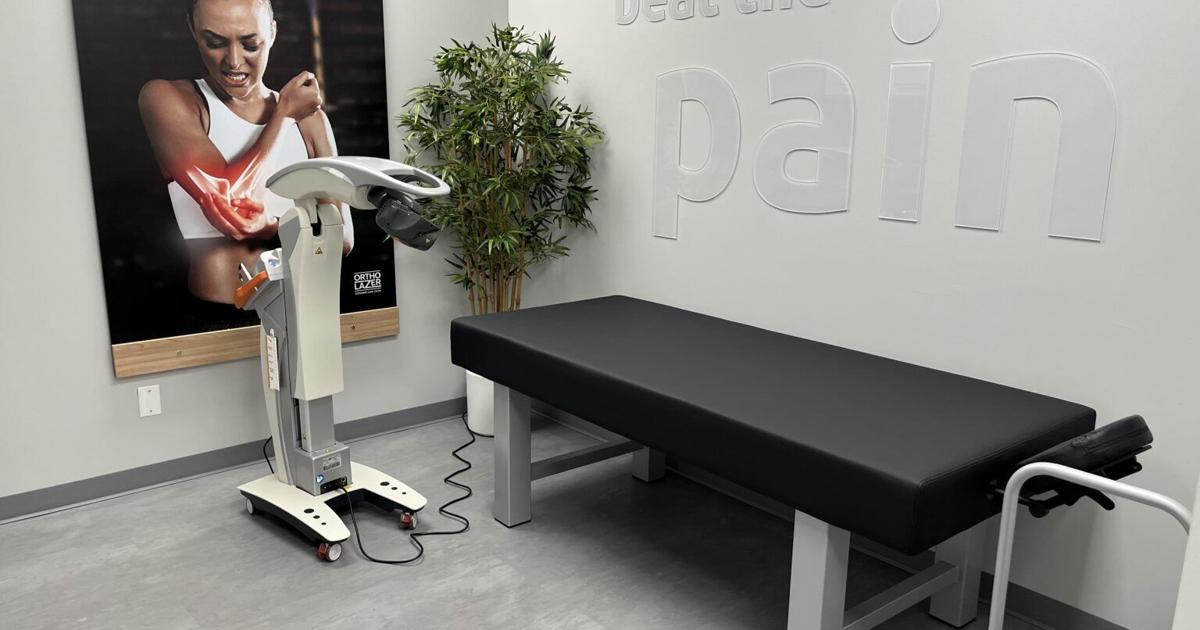[ad_1]
LOUISVILLE Stefanie Nasca’s car is her office, and she drives it at least six hours a day across Kentucky and Indiana for her lab sales job.
So, when the Louisville woman suffered back pain, she couldn’t take a break from the extensive driving and sitting.
“I would go to stand up and I’d be … hunched over,” said Nasca. “I’d be super stiff and … it would take me … a minute to kind of get upright and straight and walk.”
Reluctant to turn to pain medication, especially opioids, Nasca sought out a new treatment in Louisville: laser therapy.
“I’m definitely the type that likes to try different things before I go straight to medicine,” she said.
OrthoLazer opened a franchise location in Louisville to internal referrals in August, and to other patients in September at 3600 Springhurst Boulevard, Suite 3604.
A physician team uses a MLS M8 Robotic Laser to treat musculoskeletal pain and stiffness and has served at least 135 patients so far. Each treatment typically takes 12 or fewer minutes and patients usually need six to 12 treatments.
The physicians running the new clinic hope to provide an alternative to opioids for pain relief, they said, and help turn the tide of the opioid epidemic.
U.S. physicians have been dispensing far fewer opioid painkillers since prescriptions for the highly addictive drugs peaked in 2012. Even at the lowest dispensing rate in 15 years, there were 142 million total prescriptions for opioids in 2020, reports the Centers for Disease Control and Prevention. Among states Kentucky has one of the highest rates of opioid dispensing — 68.2 prescriptions per 100 people in 2020 compared with the national rate of 43.3 prescriptions per 100 people.
Although Kentucky saw its first decline in fatal overdoses since 2018 last year, 2,135 Kentuckians died from an overdose in 2022. Most of those deaths were from opioids, especially fentanyl.
Laser treatments are a potential alternative for patients seeking to relieve pain associated with injuries, arthritis, nerve pain, surgery recovery (as long as there isn’t a cast or bandaging blocking the wound) and more.
After wrapping up the first of six treatments — two a week — in September, Nasca said she started feeling better.
“I was still stiff, but not as bad as I was,” she recalled after that first treatment. “And then by the time my sixth one was done, I didn’t have (stiffness) at all.”
She’s still in her car the same number of hours every week — but now, she said, “My back feels completely fine.”
The goal: ‘opioid free surgery’
The goal is to eventually have opioid-free surgery with the potential for a laser prescription instead of a pill bottle to relieve post-surgical pain, said Dr. Ryan Krupp, an orthopedic surgeon focused on shoulders.
The laser robot — who the team jokingly called “Marty” — works by “taking the light energy, and harnessing that to enhance the body’s response,” Krupp explained. “You’re not doing anything different than the body wants to do.”
The treatment uses specific wavelengths of light to enter damaged cells and stimulate intracellular activity, Krupp explained. “This turns off the inflammatory process, which for the patient means reduced pain in the area, a faster recovery time, and improved function.”
OrthoLaser Louisville is still new, but the team wants to see it expanded eventually, Krupp said.
Krupp is joined at the center by knee and hip orthopedic surgery specialists Dr. Joseph W. Greene and Dr. Jonathan Yerasamides, anesthesiologist and pain management specialist, S. Kyle Young and neuromusculoskeletal specialist Dr. Mark Conliffe.
What does research say about laser treatments?
“Laser therapy has been around since the 1960s, but there have been great advancements of late,” Green said in a statement.
He pointed to the American Academy of Orthopedic Surgeons saying in 2021 that laser therapy can be used to treat osteoarthritis.
In 2022, the Centers for Disease Control and Prevention also mentioned low-level laser therapy in a series of non-opioid recommendations for pain management.
“This is not just academic − OrthoLazer outcomes are real,” Green added.
Multiwave Locked System (MLS) Laser treatment “significantly” decreased pain in participants with chronic neck pain who received the treatment during a study, according to the results published in the National Library of Medicine in 2017.
“MLS laser therapy in conjunction with exercises decreased pain and increased functional activity following 6 months of therapy,” researchers for that trial wrote at the time.
Financial accessibility
Insurance doesn’t cover laser therapy, so anyone getting it must pay out of pocket or use health savings account or flexible spending account money. OrthoLazer in Louisville charges $450 for a package of six visits and $780 for the 12-visit package, Krupp said.
“There’s a million different things in the market,” Krupp said. “I get stuff pitched to me all the time.”
He always wants to know, he said: “does this have any kind of validity for patients?” and “is it so cost prohibitive that nobody’s going to use it anyway?”
Laser therapy, he said, “is one of the few things that I’ve come across (that) kind of checks both boxes. Yes, there is a cost to it. But it’s not an exorbitant pricing.”
That money was worth it to Louisville’s Nasca, who works for a diagnostics lab.
“I feel like so many people at this point are so aware and concerned about being on opioids,” she said. “We’ve seen that it can be anybody from a CEO to a high school student.”
“You have to be willing to pay,” she acknowledged, “but I think that people that are extremely concerned about any sort of opioid intake would be willing to pay out of their pocket. I think people are scared to take opioids, which is also not a bad thing to help the epidemic. But if there’s alternatives for them, I just think it’s the best option.”
[ad_2]
Source link



